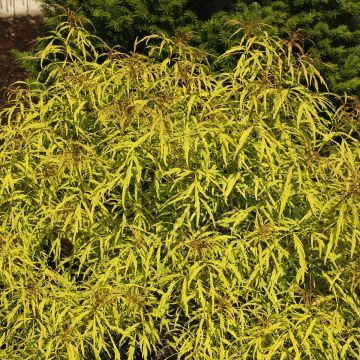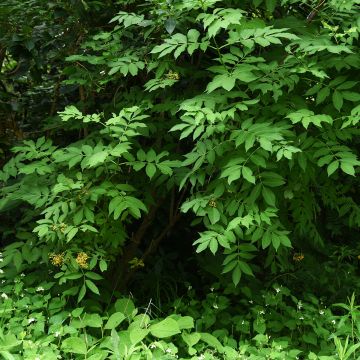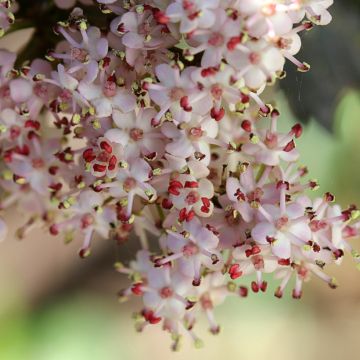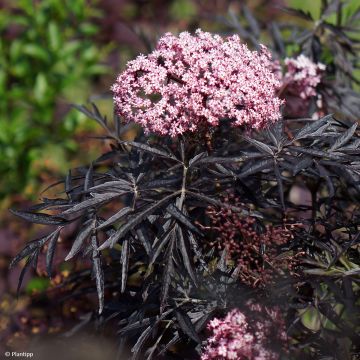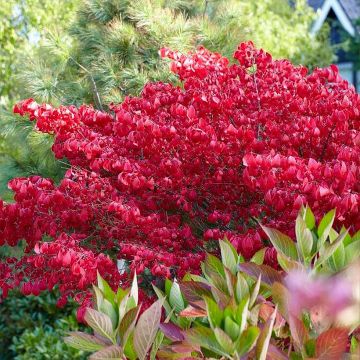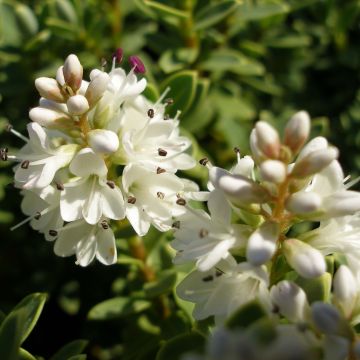

Sambucus nigra Straight Laced - Black Elder
View more pictures
Hide images

Cedric V.

Cédric
Cedric V. • BE
Sambucus nigra Straight Laced - Black Elder
Sambucus nigra Straight Laced
European Elder, Black Elder, Elder, Elderberry, European Elderberry, European black Elderberry
Planted in the ground in spring 2023. Well established and beautiful growth. It measured 40 cm upon arrival and now it's nearly 1.50 m tall. It loses its leaves late and grows new leaves very early in spring. The flowers are splendid and are enhanced by the dark foliage which is magnificent.
LB, 12/02/2025
Special offer!
Receive a €20 voucher for any order over €90 (excluding delivery costs, credit notes, and plastic-free options)!
1- Add your favorite plants to your cart.
2- Once you have reached €90, confirm your order (you can even choose the delivery date!).
3- As soon as your order is shipped, you will receive an email containing your voucher code, valid for 3 months (90 days).
Your voucher is unique and can only be used once, for any order with a minimum value of €20, excluding delivery costs.
Can be combined with other current offers, non-divisible and non-refundable.
Why not try an alternative variety in stock?
View all →This plant carries a 24 months recovery warranty
More information
We guarantee the quality of our plants for a full growing cycle, and will replace at our expense any plant that fails to recover under normal climatic and planting conditions.

Would this plant suit my garden?
Set up your Plantfit profile →
Description
Sambucus nigra Straight Laced is a particularly striking form of the Black Elderberry. This very beautiful deciduous bush with an almost columnar habit is adorned with finely cut foliage, reminiscent of herbaceous peonies or certain Japanese maples. Adding to its unique look, these decorative leaves take on an almost black colour. The dark mass of the foliage thus provides a perfect setting to highlight the spring flowering, which blooms in the form of large pinkish corymbs. This elegant Elderberry accepts most soils, provided they are fertile and moist, and its compact dimensions also allow it to be grown in containers. Very hardy and easy to grow, it is a great find for small gardens!
Sambucus nigra Straight Laced is a plant that was classified in the Caprifoliaceae family (like honeysuckles) but is now assigned to the Adoxaceae, a rather obscure botanical family whose other main (large) known genus is Viburnum. It is a variety derived from the black elderberry, Sambucus nigra, a wild species found in Europe, North Africa, and as far as Asia Minor. In nature, it is a gracefully spreading and rounded bush, supported by arching branches, which can reach several metres in height and width. Its growth is rapid, especially in the fertile and moist soils that it prefers, and its exuberant habit makes it too cumbersome for some gardens.
Fortunately, many more disciplined cultivars (horticultural varieties) allow for the enjoyment of this interesting bush, especially for its nectar-rich flowering that is beneficial to bees. Straight Laced is a recent variety, introduced to the market in 2018, and its compactness is a great asset. There are several cultivars with almost black foliage, but most have retained the cumbersome aspect of the wild species, which is not the case with this one. The Straight Laced Elderberry reaches a height of 2.50 m (maximum 3 m (10 ft)) and takes on an almost columnar shape, not exceeding 1.30 m (4ft) in width. This limited growth allows it to be planted anywhere: in borders, as a focal point at the corner of a wall, in a mixed hedge, and even in a container. It will then only need to be pruned once a year to limit its growth, and it can add character to your terrace or mark a pathway.
Its finely cut foliage is particularly attractive, especially since its very dark, almost black, purple colour is truly unique. With its striking upright habit, this small elderberry will work well in a modern setting, blending perfectly with white walls and slate roofs. It produces truly delightful and very tasteful flowering, consisting of large corymbs of pinkish flowers which contrast nicely with the dark foliage in May-June. And if you plant a co-pollinator nearby (about ten metres away), the fertilised flowers will then develop into small purple-black fruits, characteristic of the species. For this purpose choose a variety such as 'Black Lace', 'Black Beauty', or 'Instant Karma' to achieve cross-pollination, which will allow both plants to bear fruit.
Easy to grow, this bush thrives equally well in full sun or partial shade. Undemanding in terms of soil type, it does appreciate fertile and moist soil. Under these conditions, it requires almost no maintenance, except for occasional pruning to correct its habit or limit its height. Very hardy, it can grow anywhere, and is more sensitive to excessive heat than to cold. If you choose to plant it in a container, you will need to use a soil that retains water well and a container with sufficiently insulating walls (thick terracotta or "double-skin" plastic with an air gap between the inner and outer walls) to prevent overheating of the substrate. Preferably place your container in a shaded spot in the afternoon sun and, in any case, remember to water regularly during hot periods.
The Straight Lace Elderberry is one of those jewel plants that is easy to fall for. Its habit, the shape and colour of its foliage, its abundant flowering, everything about it is appealing. Its multiple advantages allow it to be grown as a standalone specimen in the ground or in a decorative container, at the corner of a terrace, or by a winding path on a lawn. It will also look great in combination with other shrubs and perennials, or even as a backdrop for small trees in a mixed border. Have fun with colour contrasts by planting the Philadelphus coronarius Aureus next to it, a beautiful Mock Orange with golden foliage and enchanting white flowers (plant it in light shade to prevent its leaves from scorching in bright sunlight). In full sun, opt for the Physocarpus opulifolius Angel Gold, which is easier to grow and just as contrasting with the black of Straight Lace. For a more subtle harmony, the classic Cornus alba Elegantissima, a Dogwood with green leaves variegated with white, would also make a perfect partner.
Good to know: elderberry leaves are known to accelerate compost decomposition. A liquid fertiliser made from black elderberry leaves is useful in organic gardening to combat mildew and aphid attacks, or to deter rodents. Simply macerate 1 kg of leaves in 10 L of water for a few days, and spray as needed. It can also be planted in an orchard, where it attracts insect-eating birds.
Report an error about the product description
Sambucus nigra Straight Laced - Black Elder in pictures


Plant habit
Flowering
Foliage
Botanical data
Sambucus
nigra
Straight Laced
Adoxaceae
European Elder, Black Elder, Elder, Elderberry, European Elderberry, European black Elderberry
Cultivar or hybrid
Other Sambucus - Elder tree
View all →Planting and care
Easy to grow, the Straight Laced Elderberry is preferably planted in autumn to benefit from rain, or in spring but then it will need more watering afterwards. Plant it in any ordinary soil, but more fertile than poor, and if possible moist as it doesn't tolerate dryness too well. Choose a sunny or semi-shaded location, and dig a planting hole at least 50 cm (20in) in all directions. Soak the root ball in a bucket of water for fifteen minutes (until completely soaked). Mix planting compost with the existing soil, position the root ball so that the top is level with the ground, fill in the soil around it and water generously. Water regularly afterwards during the first two years to promote root development, and then during hot periods.
To bear fruit, this Elderberry needs another nearby pollinator, such as 'Black Lace', 'Black Beauty' or 'Instant Karma'.
Planting period
Intended location
Care
-
, onOrder confirmed
Reply from on Promesse de fleurs
Similar products
Haven't found what you were looking for?
Hardiness is the lowest winter temperature a plant can endure without suffering serious damage or even dying. However, hardiness is affected by location (a sheltered area, such as a patio), protection (winter cover) and soil type (hardiness is improved by well-drained soil).

Photo Sharing Terms & Conditions
In order to encourage gardeners to interact and share their experiences, Promesse de fleurs offers various media enabling content to be uploaded onto its Site - in particular via the ‘Photo sharing’ module.
The User agrees to refrain from:
- Posting any content that is illegal, prejudicial, insulting, racist, inciteful to hatred, revisionist, contrary to public decency, that infringes on privacy or on the privacy rights of third parties, in particular the publicity rights of persons and goods, intellectual property rights, or the right to privacy.
- Submitting content on behalf of a third party;
- Impersonate the identity of a third party and/or publish any personal information about a third party;
In general, the User undertakes to refrain from any unethical behaviour.
All Content (in particular text, comments, files, images, photos, videos, creative works, etc.), which may be subject to property or intellectual property rights, image or other private rights, shall remain the property of the User, subject to the limited rights granted by the terms of the licence granted by Promesse de fleurs as stated below. Users are at liberty to publish or not to publish such Content on the Site, notably via the ‘Photo Sharing’ facility, and accept that this Content shall be made public and freely accessible, notably on the Internet.
Users further acknowledge, undertake to have ,and guarantee that they hold all necessary rights and permissions to publish such material on the Site, in particular with regard to the legislation in force pertaining to any privacy, property, intellectual property, image, or contractual rights, or rights of any other nature. By publishing such Content on the Site, Users acknowledge accepting full liability as publishers of the Content within the meaning of the law, and grant Promesse de fleurs, free of charge, an inclusive, worldwide licence for the said Content for the entire duration of its publication, including all reproduction, representation, up/downloading, displaying, performing, transmission, and storage rights.
Users also grant permission for their name to be linked to the Content and accept that this link may not always be made available.
By engaging in posting material, Users consent to their Content becoming automatically accessible on the Internet, in particular on other sites and/or blogs and/or web pages of the Promesse de fleurs site, including in particular social pages and the Promesse de fleurs catalogue.
Users may secure the removal of entrusted content free of charge by issuing a simple request via our contact form.
The flowering period indicated on our website applies to countries and regions located in USDA zone 8 (France, the United Kingdom, Ireland, the Netherlands, etc.)
It will vary according to where you live:
- In zones 9 to 10 (Italy, Spain, Greece, etc.), flowering will occur about 2 to 4 weeks earlier.
- In zones 6 to 7 (Germany, Poland, Slovenia, and lower mountainous regions), flowering will be delayed by 2 to 3 weeks.
- In zone 5 (Central Europe, Scandinavia), blooming will be delayed by 3 to 5 weeks.
In temperate climates, pruning of spring-flowering shrubs (forsythia, spireas, etc.) should be done just after flowering.
Pruning of summer-flowering shrubs (Indian Lilac, Perovskia, etc.) can be done in winter or spring.
In cold regions as well as with frost-sensitive plants, avoid pruning too early when severe frosts may still occur.
The planting period indicated on our website applies to countries and regions located in USDA zone 8 (France, United Kingdom, Ireland, Netherlands).
It will vary according to where you live:
- In Mediterranean zones (Marseille, Madrid, Milan, etc.), autumn and winter are the best planting periods.
- In continental zones (Strasbourg, Munich, Vienna, etc.), delay planting by 2 to 3 weeks in spring and bring it forward by 2 to 4 weeks in autumn.
- In mountainous regions (the Alps, Pyrenees, Carpathians, etc.), it is best to plant in late spring (May-June) or late summer (August-September).
The harvesting period indicated on our website applies to countries and regions in USDA zone 8 (France, England, Ireland, the Netherlands).
In colder areas (Scandinavia, Poland, Austria...) fruit and vegetable harvests are likely to be delayed by 3-4 weeks.
In warmer areas (Italy, Spain, Greece, etc.), harvesting will probably take place earlier, depending on weather conditions.
The sowing periods indicated on our website apply to countries and regions within USDA Zone 8 (France, UK, Ireland, Netherlands).
In colder areas (Scandinavia, Poland, Austria...), delay any outdoor sowing by 3-4 weeks, or sow under glass.
In warmer climes (Italy, Spain, Greece, etc.), bring outdoor sowing forward by a few weeks.


































